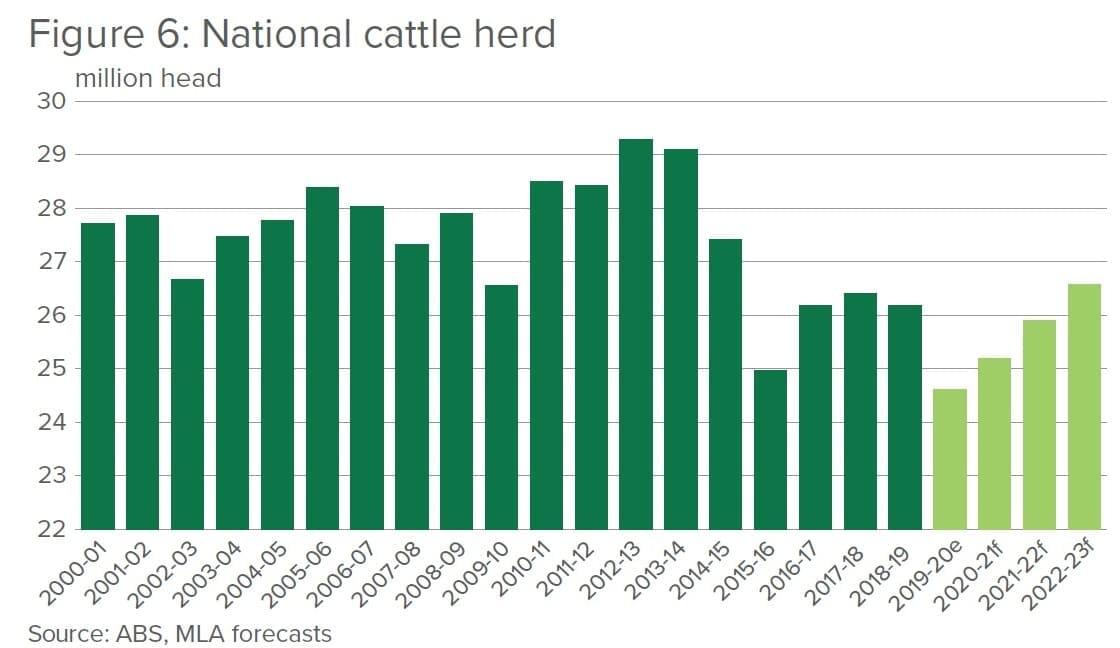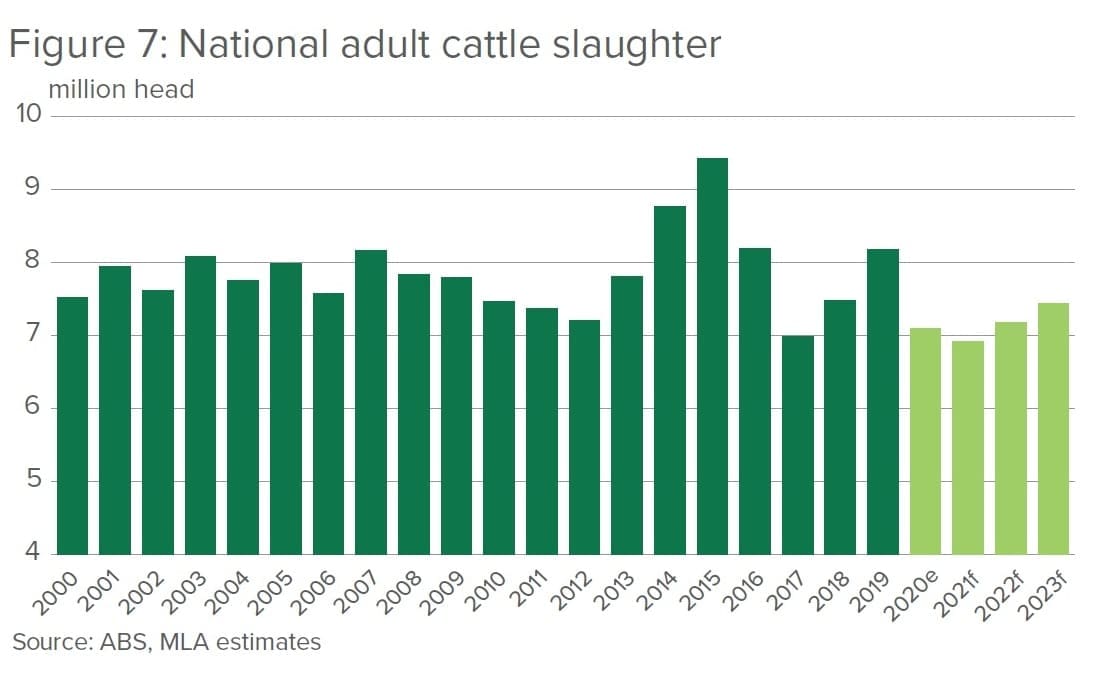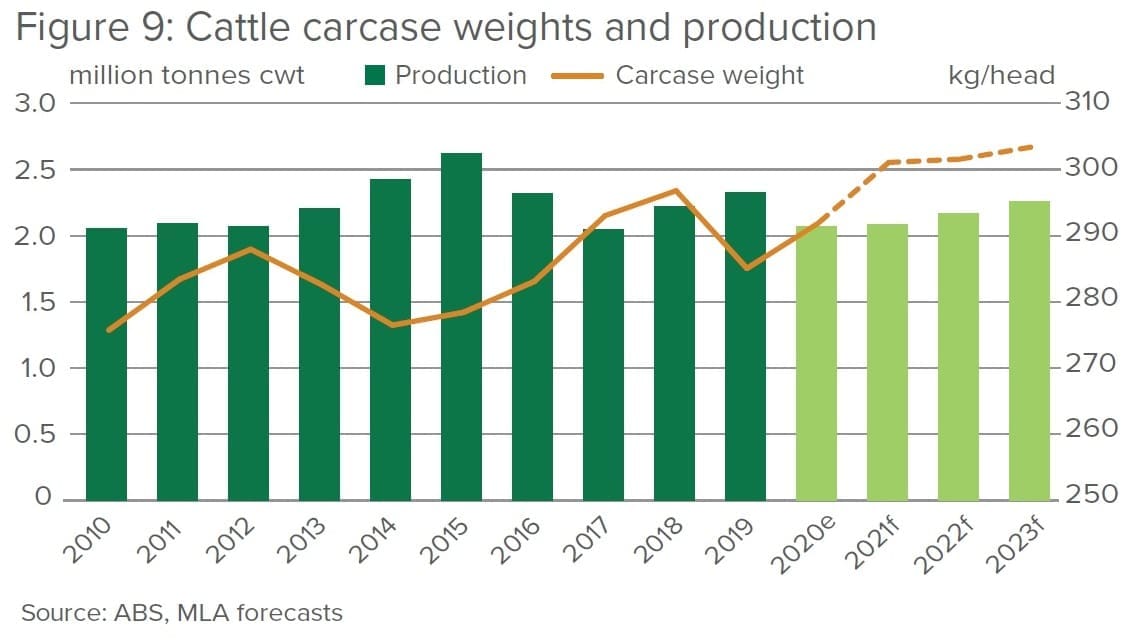AUSTRALIAN beef herd rebuilding is underway following two years of severe drought, with the nation’s cattle herd expected to increase two percent to 25.2 million head in 2021, according to Meat & Livestock Australia’s 2021 annual Cattle Industry Projections released this morning.
The rebuild comes after cattle numbers fell to 24.6 million head last year – their lowest level since the early 1990s.
Improved seasonal conditions in southern Australia throughout 2020, and above-average summer rain in northern Australia during the 2020–21 wet season so far, are expected to produce an abundance of pasture in major cattle producing regions across Australia except parts of Western Australia.
The 2021 cattle projections have been based on a series of assumptions:
- That the La Niña will bring above-average rainfall to Queensland and northern Australia during the 2020–21 summer period, and above-average rainfall to the eastern mainland over the first quarter of 2021.
- A global COVID recovery will begin in 2021, aligning with forecasts made by the International Monetary Fund and supported by the initial rollout of vaccines in the US, Europe and Asia.
- Exchange rate: In 2021, the major banks anticipate the A$ will remain strong, with some reports suggesting it could reach US80¢ by December, while most have it pegged between US75¢ and US78¢ at the end of the year.
Cattle supply is expected to tighten in 2021, as producers retain more breeding stock to rebuild their herds. The increase in heifers being retained for breeding purposes will cause the female slaughter percentage to drop in the second half of 2021, MLA forecasts.
Producer intentions to retain more cattle will also see slaughter levels fall further. In 2021, cattle slaughter is expected to decline by 3pc to 6.9 million head – the lowest level in 25 years. During the first few weeks of 2021 this dynamic has already been evident, with yardings and slaughter numbers well down on year-ago levels.
MLA’s market information manager, Stephen Bignell, said 2021 represented a new frontier for the Australian cattle market, with the combination of a reduced herd, record high prices and a global market attempting to recover from the COVID-19 pandemic.
“Cattle supply is expected to tighten in 2021 as producers retain more breeding stock to rebuild their herds,” Mr Bignell said.
“The increase in cattle being retained for breeding purposes will cause the female slaughter percentage to drop, and in the second half of 2021, this is expected to fall below 47pc, signalling a technical rebuild.”
Mr Bignell said despite the expectations for slaughter to decline, national beef production is forecast to remain unchanged at 2.1 million tonnes carcase weight, similar to 2020 and levels recorded in 2017, which was also a herd rebuilding year.
“Beef production is underpinned by a forecast increase in carcase weights. In 2021, national adult carcase weights are forecast to lift 3.2pc on 2020 levels, to average 301.3kg per head,” Mr Bignell said.
The lift would largely be driven by an increase in the male portion of slaughter, coinciding with a fall in the number of females turned-off during the year.
Carcase weights have trended steadily upwards for 20 years, with slight variations due to seasonal conditions.
The growing size of the feedlot sector, with more than one million head on feed, will also contribute to rising carcase weights.
Beef exports are expected to lift 2pc in 2021 to 1.1 million tonnes shipped weight, growing to 1.2 million tonnes in 2023.
“In 2020, COVID-19 affected demand for beef in key markets due to the global drop in foodservice activity and market access issues. Global growth GDP of 5pc is forecast in 2021, which should see global demand for beef rebound,” Mr Bignell said.
Despite the COVID disruption, there is evidence that the domestic beef market remained solid in 2020, with Australia one of the largest per capita consumers of beef in the world and the domestic market still the single largest buyer of Australian beef.
Australian live cattle exports for 2021 are expected to be 960,000 head, down 9pc on 2020 levels. However, demand from South East Asia for Australian cattle is expected to recover in the second half of the year.
Unchartered territory
This year represented uncharted territory for Australian beef producers, the 2021 Projections document suggests.
The herd rebuild is likely to be more gradual than previous cycles, owing to a smaller breeding base and one of the worst droughts on record. The herd is also reduced, prices are high and although the COVID-19 recovery is beginning, its impacts will still be felt for years to come. All of these factors represent opportunities for the Australian beef industry to improve its domestic and global standpoint, and challenges that will require adaptation to overcome.
Click here to read MLA’s 2021 Cattle Industry Projections




My first comment relates to MLA’s ignorance that there has only been 2 years of severe drought. There has been severe drought in a very large percentage of Queensland, the largest cattle production state, for 7-8 years, consecutively.
The cattle herd is much smaller than you guys think. You only have to get off your ass and go for a drive.
The percentage of female kill has been greater than male kill for years. This almost decade long drought in much of Queensland will take at least a decade to fix itself.
Not only the drought, but we also had a huge hit on cattle numbers in the Gulf in 2019, when hundreds of thousands of cattle perished in a very short lived flood, which, in most cases only added to the drought.
So, in my humble opinion, this female shortage is here to stay for a long time, especially given the price producers can expect for any class of livestock.